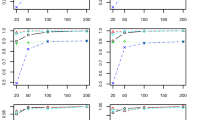Abstract
The problem of how to find the best decision rule in the course of a search, based on sample set analysis, is considered. Specifically the problem of selecting the best subset of regressors is highlighted. In the considered formulation the problem is an important case of how to learn a dependence by examples.
The concept of Predictive Probabilistic Estimate (PPE) is introduced and its properties are discussed. Asymptotic properties of PPE are based on Vapnik-Chervonenkis theory of uniform convergence of a set of sample estimates. Finite-sample-size properties of PPE demonstrate how PPE takes into account the presence of a search process and the complexity of a regression formula, while estimating quality of fit. Some practical and model examples are presented.
Similar content being viewed by others
Explore related subjects
Discover the latest articles, news and stories from top researchers in related subjects.References
M.A. Aitkin, Simultaneous inference and the choice of variable subsets, Technometrics 16 (1974) 221–227.
V.L. Brailovsky and I.Yu. Brailovsky, Method of predicting solar flares with a function of many variables, English translation: Sov. Phys., Doklady (1972) 335–337.
K.N. Berk, Comparing subset regression procedures, Technometrics 20 (1978) 1–6.
L. Breiman, J.H. Friedman, R.A. Olsen and C.J. Stone,Classification and Regression Trees (Wadsworth, Belmont, CA, 1984).
A. Blumer, A. Ehrenfencht, D. Haussler and M. Warmuth, Classifying learnable geometric concepts with the Vapnik-Chervonenkis dimension,Proc. 18th Annual ACM Symp. on Theory of Computing, Berkeley, CA (May 1986) pp. 273–282.
V.L. Brailovsky, A predictive probabilistic estimate for selecting subsets of regressor variables, Ann. N.Y. Acad. Sci. 491 (1987) 233–244.
V.L. Brailovsky, On the use of a predictive probabilistic estimate for selecting best decision rules in the course of search,Proc. IEEE Computer Society Conf. on Computer Vision and Pattern Recognition, Ann Arbor, MI (1988) pp. 469–477.
V.L. Brailovsky, A probabilistic estimate of clustering,Proc. 10th Int. Conf. on Pattern Recognition, Atlantic City, NJ (June 1990) vol. 1, pp. 953–956.
G. Diehr and D.R. Hoflin, Approximating the distribution of the sampleR 2 in best subset regressions, Technometrics 16 (1974) 317–330.
N. Draper and H. Smith,Applied Regression Analysis (Wiley, 1966).
V.F. Flack and P.C. Chang, Frequency of selecting noisy variables, The Amer. Statist. 41 (1987) 84–86.
A.B. Forsythe, L. Engleman, P.R.A. May and R. Jennrich, A stopping rule for variable selection in multiple regression analysis, J. Amer. Statist. Assoc. 68 (1973) 75–77.
J.W. Gorman and R.J. Torman, Selection of variables for fitting equations to data, Technometrics 8 (1966) 27–51.
A. Hald,Statistical Theory with Engineering Applications (Wiley, 1952).
A.L. Luntz and V.L. Brailovsky, Evaluation of attributes obtained in statistical decision rules, English translation: Eng. Cybern. 3 (1967) 98–109.
A.J. Miller, Selection of subsets of regression variables, J. Roy. Stat. Soc. A147 (1984) part 2.
R.G. Miller, Statistical prediction by discriminant analysis, Meteorol. Monog., Am. Meteorol. Soc. 4 (1962) 21.
I.Sh. Pinsker, The chaotization principle and its application in data analysis, in:Models, Algorithms, Decision Making, ed. I. Pinsker (Nauka, Moscow, 1979) (in Russian).
A.C. Rencher and F.C. Pun, Inflation ofR 2 in best subset regression, Technometrics 22 (1980) 49–53.
J. Rissanen, Modelling by shortest data description, Automatica 14 (1978) 465–471.
J. Rissanen, A universal prior for integers and estimation by minimum description length, Ann. Statist. 11 (2) (1983) 416–431.
G.A.F. Seber,Linear Regresion Analysis (Wiley, 1977).
V.N. Vapnik and A.Ja. Chervonenkis,Theory of Pattern Recognition (Nauka, Moscow, 1974) (in Russian).
V.N. Vapnik,Estimation of Dependencies, Based on Empirical Data (Springer, 1982).
Author information
Authors and Affiliations
Rights and permissions
About this article
Cite this article
Brailovsky, V.L. Search for the best decision rules with the help of a probabilistic estimate. Ann Math Artif Intell 4, 249–267 (1991). https://doi.org/10.1007/BF01531059
Issue Date:
DOI: https://doi.org/10.1007/BF01531059




